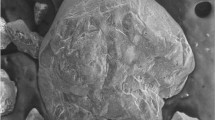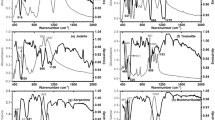Abstract
Recently, near infrared spectroscopy in combination with double derivative technique has been effectively used by Christy (Vib Spectrosc 54:42–49, 2010) to study and differentiate between free and hydrogen bonded silanol groups on silica gel surface. The method has given some insight into the type of functionalities, their location in silica gel samples, and the way the water molecules bind onto the silanol groups. The important information in this respect comes from the overtones of the OH groups of water molecules hydrogen-bonded to free silanol groups, and hydrogen-bonded silanol groups absorbing in the region 5,500–5,100 cm−1. Chemically, opal minerals are hydrated silica and the same approach was adapted to study the state of water molecules, silanol functionalities, and their locations in opal samples from Slovakia. Twenty opal samples classified into CT and A classes and one quartz sample were used in this work. The samples were crushed using a hydraulic press and powderized. Each sample was then subjected to evacuation process to remove surface-adsorbed water at 200°C, and the near infrared spectrum of each sample was measured using a Perkin Elmer NTS FT-NIR spectrometer equipped with a transflectance accessory and a DTGS detector. The samples were also heated to 750°C to remove the hydrogen-bonded silanol groups on the surface to reveal their locality. Second derivative profiles of the near infrared reflectance spectra were obtained using the instrument’s software and used in the detailed analysis of the samples. The analysis of the near infrared spectra and their second derivative profiles had the aim in finding relationships between the surface chemical structure and the classification of opal samples. The dry opal samples were also tested for their surface adsorption effectivity toward water molecules. The results indicate that the opal samples contain (1) surface-adsorbed water, (2) free and hydrogen-bonded silanol groups on the surface, (3) trapped water molecules in the bulk, and (4) free and hydrogen-bonded silanol groups in the cavity surfaces in the bulk. A part of the water molecules in the bulk of opal minerals are found as free molecules and the rest are found in hydrogen-bonded state to either free or vicinal or geminal silanol groups.









Similar content being viewed by others
References
Anderson JH, Wickersheim KA (1964) Near infrared characterization of water and hydroxyl groups on silica surfaces. Surf Sci 2:251–260
Armistead CG, Tyler AJ, Hambleton FH, Mitchell SA, Hockey JA (1969) Surface hydroxylation of silica. J Phys Chem 73(11):3947–3953
Boboň M (2011) Physical characteristics of natural quartz oxides. Comparison of Selected physical properties of opal from Slovakia. Dissertation work., FPV UKF Nitra (unpublished)
Boehm HP (1966) Chemical identification of surface groups. Adv Catal 16:179–274
Burneau A, Barres O, Gallas JP, Lavalley JC (1990) Comparative-study of the surface hydroxyl-groups of fumed and precipitated silicas. 2. characterization by infrared-spectroscopy of the interactions with wate. Langmuir 6:1364–1372
Bush SG, Jorgenson JW (1990) Confirmation and application of transmission near-infrared absorption technique for absolute quantitation of functional-groups on silica-gel. J Chromatogr 503:69–91
Bush SG, Jorgenson JW, Miller ML, Linton RW (1983) Transmission near-infrared technique for evaluation and relative quantitation of surface groups on silica. J Chromatogr 260:1–12
Christy AA (2010) New insights into the surface functionalities and adsorption evolution of water molecules on silica gel surface: a study by second derivative near infrared spectroscopy. Vib Spectrosc 54:42–49
Christy AA (2011) Near infrared characterisation of surface hydroxyl groups on Hydro-thermally treated silica. Int J Chem Envir Eng 2(1):27–32
Graetsch H (1994) Structural characteristics of opaline and microcrystalline silica minerals. In: Heaney PJ, Prewitt CT Gibbs GV (eds) Silica. Physical behaviour, geochemistry and materials applications,.reviews in mineralogy 29, Mineralogical Society of America, pp 209–232
Hall PG, Williams RT, Slade RCT (1985) Nuclear magnetic-resonance and dielectric-relaxation investigations of water sorbed by spherisorb silica. J Chem Soc Faraday I 81:847–855
Hendry JP, Trewin NH (1995) Authiogenic quartz microfabrics in cretaceous turbidites: evidence for silica transformation processes in sandstones. J Sediment Res A65(2):380–392
Hoffman P, Knozinger E (1987) Novel aspects of mid and far IR fourier spectroscopy applied to surface and adsorption studies on SiO2. Surf Sci 188:181–198
Jones JB, Segnit ER (1971) The nature of opal 1. Nomenclature and constituent phases. J Geol Soc Austr 18(1):57–68
Klier K, Shen JH, Zettlemoyer AC (1973) Water on silica and silicate surfaces. 1. partially hydrophobic silica. J Phys Chem 77(11):1458–1465
Kondo S, Muroya M (1969) Surface structure of silica gel studied by dielectric dispersion Bull. Chem Soc Jpn 42:1165–1170
Lange KR (1965) The characterisation of molecular water on silica surfaces. J Coll Sci 20:231–240
Langer K, Flörke OW (1974) Near infrared absorption spectra (4000–9000 cm-1) of opals and the role of “water” in these SiO2•nH2O minerals. Fortschr Miner 52(1):17–51
Lipp ED (1992) Near-infrared spectroscopy of silicon-containing materials Appl. Spectrosc Rev 27(4):385–408
Low MJD, Ramasubramanian N (1966) Infrared study of nature of hydroxyl groups on surface of porous glass. J Phys Chem 70(9):2740–2748
Morrow BA, McFarlan AJ (1991) Infrared and gravimetric study of an aerosil and a precipitated silica using chemical and h/d exchange probes. Langmuir 7:1695–1701
Morrow BA, Cody IA, Lee LSM (1976) Infrared studies of reactions on oxide surfaces.7 mechanism of adsorption of water and ammonia on dehydroxylated silica. J Phys Chem 80:2761–2767
Pelmenschikov AG, Morosi G, Gamba A (1997) Adsorption of water and methanol on silica hydroxyls: ab initio energy and frequency calculations. J Phys Chem A 101:1178–1187
Scott RPW, Traiman S (1980) Solute-solvent interactions on the surface of silica-gel.3. multilayer adsorption of water on the surface of silica-gel. J Chromatogr 196:193–205
Sermon PA (1980) Interaction of water with some silicas. J Chem Soc Faraday I 76:885–888
Stein CL, Kirkpatrick RJ (1976) Experimental porcelanite recrystallisation kinetics; a nucleation and growth model. J Sediment Res 46(2):430–435
Stone J, Walrafen GE (1982) Overtone vibrations of oh groups in fused-silica optical fibers. J Chem Phys 76(4):1712–1722
Williams LA, Parks GA, Crerar DA (1985) Silica diagenesis, I. solubility controls. J Sediment Petrol 55(3):301–311
Yamauchi H, Kondo S (1988) The structure of water and methanol adsorbed on silica-gel by ft-nir spectroscopy. Colloid Polym Sci 266:855–861
Yuan P, Wu DQ, He HP, Lin ZY (2004a) The hydroxy1 species and acid sites on diatomite surface: a combined IK and Raman study. Appl Surf Sci 227:30–39
Yuan P, He HP, Wu DQ, Wang DQ, Chen LJ (2004b) Characterization ot diatomaceous sihca by Raman spectroscopy. Spectrochim. Acta Part A 60:2941–2945
Acknowledgments
The authors would like to thank the Department of Science, Faculty of Engineering and Science, University of Agder, Kristiansand, Norway, for making available the near infrared Instrument for the analysis of opal samples. Furthermore, the Institute of Electrical Engineering SAS in Bratislava and Geological Institute SAS Banská Bystrica, Slovakia, are thanked for X-ray diffraction measurements and valuable assistance.
Author information
Authors and Affiliations
Corresponding author
Rights and permissions
About this article
Cite this article
Boboň, M., Christy, A.A., Kluvanec, D. et al. State of water molecules and silanol groups in opal minerals: a near infrared spectroscopic study of opals from Slovakia. Phys Chem Minerals 38, 809–818 (2011). https://doi.org/10.1007/s00269-011-0453-0
Received:
Accepted:
Published:
Issue Date:
DOI: https://doi.org/10.1007/s00269-011-0453-0




